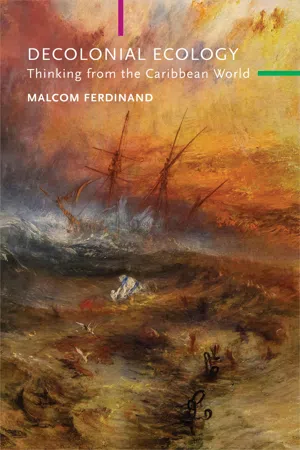
- English
- ePUB (mobile friendly)
- Available on iOS & Android
About This Book
The world is in the midst of a storm that has shaped the history of modernity along a double fracture: on the one hand, an environmental fracture driven by a technocratic and capitalist civilization that led to the ongoing devastation of the Earth's ecosystems and its human and non-human communities and, on the other, a colonial fracture instilled by Western colonization and imperialism that resulted in racial slavery and the domination of indigenous peoples and women in particular.
In this important new book, Malcom Ferdinand challenges this double fracture, thinking from the Caribbean world. Here, the slave ship reveals the inequalities that continue during the storm: some are shackled inside the hold and even thrown overboard at the first gusts of wind. Drawing on empirical and theoretical work in the Caribbean, Ferdinand conceptualizes a decolonial ecology that holds protecting the environment together with the political struggles against (post)colonial domination, structural racism, and misogynistic practices.
Facing the storm, this book is an invitation to build a world-ship where humans and non-humans can live together on a bridge of justice and shape a common world. It will be of great interest to students and scholars in environmental humanities and Latin American and Caribbean studies, as well as anyone interested in ecology, slavery, and (de)colonization.
Frequently asked questions
Information
Part I
The Modern Tempest
Environmental Violence and Colonial Ruptures
1
Colonial Inhabitation: An Earth without a World
Principles of colonial inhabitation: geography, exploitation of nature, and othercide
Table of contents
- Cover
- Table of Contents
- Series Title
- Title Page
- Copyright Page
- Table of Ships
- List of Illustrations
- Dedication
- Acknowledgments
- Foreword – Angela Y. Davis
- Prologue: A Colonial and Environmental Double Fracture
- Part I The Modern Tempest: Environmental Violence and Colonial Ruptures
- 1 Colonial Inhabitation: An Earth without a World
- 2 The Matricides of the Plantationocene
- 3 The Hold and the Negrocene
- 4 The Colonial Hurricane
- Part II Noah’s Ark: When Environmentalism Refuses the World
- 5 Noah’s Ark: Boarding, or the Abandonment of the World
- 6 Reforestation without the World (Haiti)
- 7 Paradise or Hell in the Nature Preserves (Puerto Rico)
- 8 The Masters’ Chemistry (Martinique and Guadeloupe)
- 9 A Colonial Ecology: At the Heart of the Double Fracture
- Part III The Slave Ship: Rising Up from Modernity’s Hold in Search of a World
- 10 The Slave Ship: Debarking Off-World
- 11 Maroon Ecology: Fleeing the Plantationocene
- 12 Rousseau, Thoreau, and Civil Marronage
- 13 A Decolonial Ecology: Rising Up from the Hold
- Part IV A World-Ship: World-Making beyond the Double Fracture
- 14 A World-Ship: Politics of Encounter
- 15 Forming a Body in the World: Reconnecting with a Mother-Earth
- 16 Interspecies Alliances: The Animal Cause and the Negro Cause
- 17 A Worldly-Ecology: On the Bridge of Justice
- Epilogue: World-Making in the Face of the Tempest
- Index
- End User License Agreement